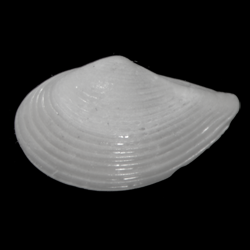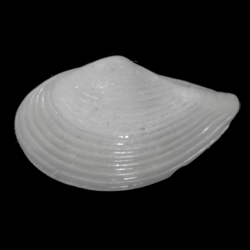
Nuculanidae

- Phylum: Mollusca
- Class: Bivalvia
- Order: Nuculanida
- Family: Nuculanidae
Overview
Common name: Pointed nut clams
Key morphological features: The Nuculanidae range in size up to 70 mm. The shells are equivalve, thin-walled, and elongated oval in shape. The posterior is either compressed or gaping at the siphonal opening. The shell is composed of aragonite and exterior sculpture is occasionally smooth, but usually consists of commarginal ridges or threads. Valve interiors are non-nacreous and the pallial line is weak, with a small to large sinus. The interior shell margins are smooth. Species of Mactridae are either isomyarian (with equally-sized adductor muscles) or heteromyarian (smaller posterior adductor muscle). The arched taxodont hinge has chevron-shaped anterior and posterior teeth. Source: Mikkelsen, P.M., and Bieler, R. 2008. Seashells of Southern Florida: Bivalves. Princeton, New Jersey: Princeton University Press. 503 pp.
Geological range: Devonian to Recent (Mikkelsen & Bieler, 2008).
Geographic distribution: A distributional map for modern Nuculanidae may be accessed from OBIS. A distributional map for ancient Nuculanidae may be accessed from the Paleobiology Database.
Diversity: There are 222 recognized living species of Nuculanidae and 12 genera (WoRMS database, unvetted). The Paleobiology Database recognizes 42 fossil genera and 334 fossil species of Nuculanidae (unvetted).
Paleoecology: The Nuculanidae are marine deposit feeders that can supplement their diet with limited suspension feeding. They live infaunally, buried in sand or mud with high organic content. Nuculanids are capable of burrowing rapidly and plowing through mud by using their planar foot. Nuculanids can be found worldwide and are most common in the deep sea. Species that live near hydrothermal vents may host endosymbiotic bacteria that oxidize sulfur. Source: Mikkelsen and Bieler (2008).
Phylogenetic status: Possibly monophyletic. The molecular phylogenetic analysis by Sharma et al. (2013) weakly supports the monophyly of Family Nuculanidae.
